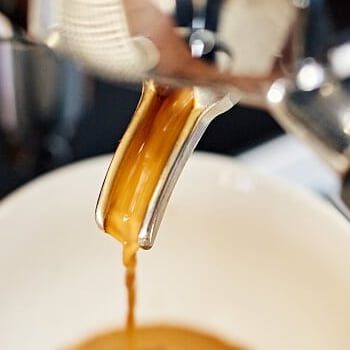
Sage Barista coffee machines reached a new high in popularity this winter. If you’ve been lucky enough to have unwrapped one yourself, there’s a good chance it was one of the models from Sage.
With entry level machines becoming more affordable, it’s easy to see how the Sage machines may have bean (excuse us…) the gift for the home coffee connoisseurs this Christmas.
In this post, we’ll talk you through the do’s and don’ts, recommended coffees and how to make the most of your new Sage coffee machine.
Click the links to go straight there
Before we get into the detail, we just want to clear up a small confusion, which is recognised among coffee drinkers – a Sage machine is different to a bean-to-cup machine. Here’s an explanation as to why:
Sage barista coffee machine vs. Bean to cup machine
With such a large variety of affordable coffee machines available, getting the right type for you may be a difficult decision. Bean to cup machines produce coffee by the touch of a button. After adding the coffee beans, the coffee will be poured with no additional input from the consumer.
These are a great addition for offices and anyone who wants espresso-based drinks in a hurry.
However, bean to cup machines do not offer the same level of control as a traditional coffee machine and lack the technology a skilled barista can use. Barista style machines allow you to add coffee to a group handle which you would then ‘tamp’ – the art of compressing the coffee so it can be fully extracted. These two stages are so commonly seen in coffee shops it is no surprise why coffee lovers want to be able to do this at home!
Which are the best coffees to use for a Sage coffee machine
With Barista coffee machines, you are spoilt for choice. With no need for a separate grinder, you can buy your preferred coffee as whole beans, rather than pre-ground. This has many benefits, not least when it comes to flavour and freshness.
Some machines are compatible with both whole beans and pre-ground coffee. It is always a good idea to check whether this is the case before buying your coffee machine, particularly if you have a personal preference in ground vs whole beans.
Our best coffee for Sage Barista coffee machines
To produce a rich espresso with plenty of flavour, opting for a dark or medium to dark roast is a good idea. This way, you will have a coffee that is also suitable for milk-based coffee drinks such as lattes, cappuccinos and flat whites, as dark roasts tend to cut through the creamy milk better than a light roast.
We recommend that you try one of the following dark roasts for your espresso coffee machine:
Sage Espresso machines – How to reduce bitterness
To make your coffee taste less bitter, reduce the length of the shot. This means reducing the actual amount of liquid that makes up the espresso shot.
Normally when producing a 2 fluid ounce shot (double) of espresso, you are pouring 60 grams of liquid weight. To make it less bitter, we want to pour 40 grams of liquid weight instead.
Because most of the Sage Espresso machines use so called pre-infusion, the extraction time from pressing the button should ideally be around 30 seconds.
The grind should produce an even flow of espresso from the group handle (also called ‘portafilter’), which is the handle with what looks like two mouse’s tails on it.
How to get the right pressure on a Sage Barista Machine
When you first buy your Sage Barista machine, it can feel very overwhelming to work out what you need to do for the perfect cup of coffee. There are just 2 key attributes of the coffee that determine whether you get the right pressure.
They are:
- Grind size
- Amount of coffee
So, let’s start with grind size. It’s important you get the right coarse level on the grind size because if the grind is too coarse, the pressure will be too low. Whereas if the coarse level is too fine, the pressure will be too high. This is mainly due to the compactness of the coffee in the portafilter.
Once you’re happy with the grind size, it’s time to work out how much coffee to use. Most people recommend 18g of coffee. Sage themselves provide a tool, which removes excess coffee, by running it round the portafilter to get the right level of coffee.
Now it’s time to test the pressure by running an espresso. Start by adjusting the grind size to see how that affects the pressure. You might use a lot of coffee during the testing phase but once you get it right, it will stay right. And getting the right pressure is a job that is very much worth it.

